10 Sep Level 1: The new rules of sports nutrition: This could revolutionize the way you coach athletes.
When you think about sports nutrition, what comes to mind?
- The lean, ripped bodies of professional athletes.
- Advanced macro ratios that are “administered” and closely monitored.
- Biochemistry, nutrient timing, and cutting-edge supplementation.
- All of the above.
Answer A, B, C, or D (everyone’s favorite)? That’s pretty typical.
There’s just one problem: Even collectively, these responses represent only a small slice of what sports nutrition is really all about.
That’s why…
It’s time we redefine sports nutrition.
And that’s exactly what we’ve done, based on our years of experience coaching elite athletes and active people.
In this article, we’ll show you how to use our new rules of sports nutrition to:
- Create nutrition plans that are truly personalized for each client.
- Implement sports nutrition with more clients than ever before.
- Develop a reliable coaching method for optimizing client results—every single time.
And most importantly? We’ll explain how this new perspective on sports nutrition doesn’t just get your clients to perform better. It can also help them live more balanced and fulfilling lives.
Because peak performance is great. But combined with a healthy, vibrant life? Now you’re truly winning.
++++
The 5 new rules of sports nutrition.
New rule #1: Don’t treat all athletes the same.
In some ways, all athletes are the same. All human bodies who move share the same general needs and basic biology.
But in other ways, all athletes are different.
For instance:
- A high school athlete in their teens isn’t the same as an experienced elite in their 20s.
- A professional athlete isn’t the same as a “regular person” who works out hard in the gym four to five times a week but also has a full-time job and two kids.
- A person with a heavy manual labor job where their body is their livelihood—such as tactical personnel in the field—isn’t the same as a person who plays a sport for fun.
Traditionally, sports nutrition has focused on the science of nutrients and making prescriptive, idealized recommendations. This typically includes designing a plan based on:
- sport type
- body weight and height
- exercise duration
- exercise intensity
- current training cycle and competition schedule
These are all crucial factors to consider. They’re something we think about a lot, in fact. (Can we interest you in a fascinating discussion of how protein needs are determined in the lab? Wait… come back.)
But in our experience, nutrients, simple body measures, and sports-based factors aren’t enough.
There’s more to a person than their stats and training schedule.
Even two people who have similar body sizes and the exact same training schedule will have important differences to account for.
Here’s an example. Derek and Vishal are youth soccer athletes. They share some key characteristics. They’re both 14, are on their school’s soccer team, and are around the same weight.
But Vishal and Derek are on a different schedule of physical and psychological development and maturity.
Check out their profiles below: Can you spot why giving them the same exact nutrition recommendations might not work so well?
Let’s take a look.
Vishal’s profile
Vishal hit puberty young. That’s given him an edge in soccer, since he’s got much longer legs and a significantly more muscular body composition than many of his teammates.
He loves playing soccer, but he never really thinks about his future in the sport. In fact, Vishal doesn’t think much about his future at all. For now, he’s just enjoying high school. After all, he’s only 14.
Derek’s profile
Derek hasn’t grown much in the past couple of years. His appetite has increased recently, but he isn’t growing at a pace to match, which means he’s gained some fat over the past few months. His dad keeps telling him, “I was a late bloomer myself.”
Derek is a fast sprinter and a talented dribbler, so he’s maintained his spot on the team’s starting lineup. He also thinks a lot about where soccer might take him. Derek hopes it’ll be his ticket to the university of his dreams, and he’s willing to do whatever it takes to ensure he gets in peak shape.
Okay, those are the details. Got your answer? See how it compares to ours.
Vishal and Derek: Why their nutrition plans should differ
Though their bodies follow the same physiological laws, and they have similar athletic demands, Vishal and Derek have different…
- Mindsets: Vishal is looking to enjoy his time on the field. Derek has a can-do attitude when it comes to eating to maximize his performance. In both cases, this will likely impact their ability to follow a nutrition plan.
- Body compositions: Vishal is on the leaner side. Derek has more body fat. This will affect their nutritional needs.
- Hormonal profiles: Vishal may have an advantage with gaining and maintaining lean muscle mass, since he’s further along in puberty.
For these reasons, if you give Derek and Vishal the exact same sports nutrition plan, they’re not going to get the same results.
Enter: movement nutrition.
We define this as nutrition that fuels, enhances, and/or promotes recovery from a wide range of activities and movements.
Movement nutrition goes beyond just the science of nutrients or prescriptive recommendations (like “eat X grams of nutrient Y”) to coaching a person in the full context of their life.
It includes:
- the science of nutrition (of course!)
- the science of behavior
- the skills and practices of systematic coaching
- the context of a client or athlete’s whole life
- the view of a client or athlete as a complete person
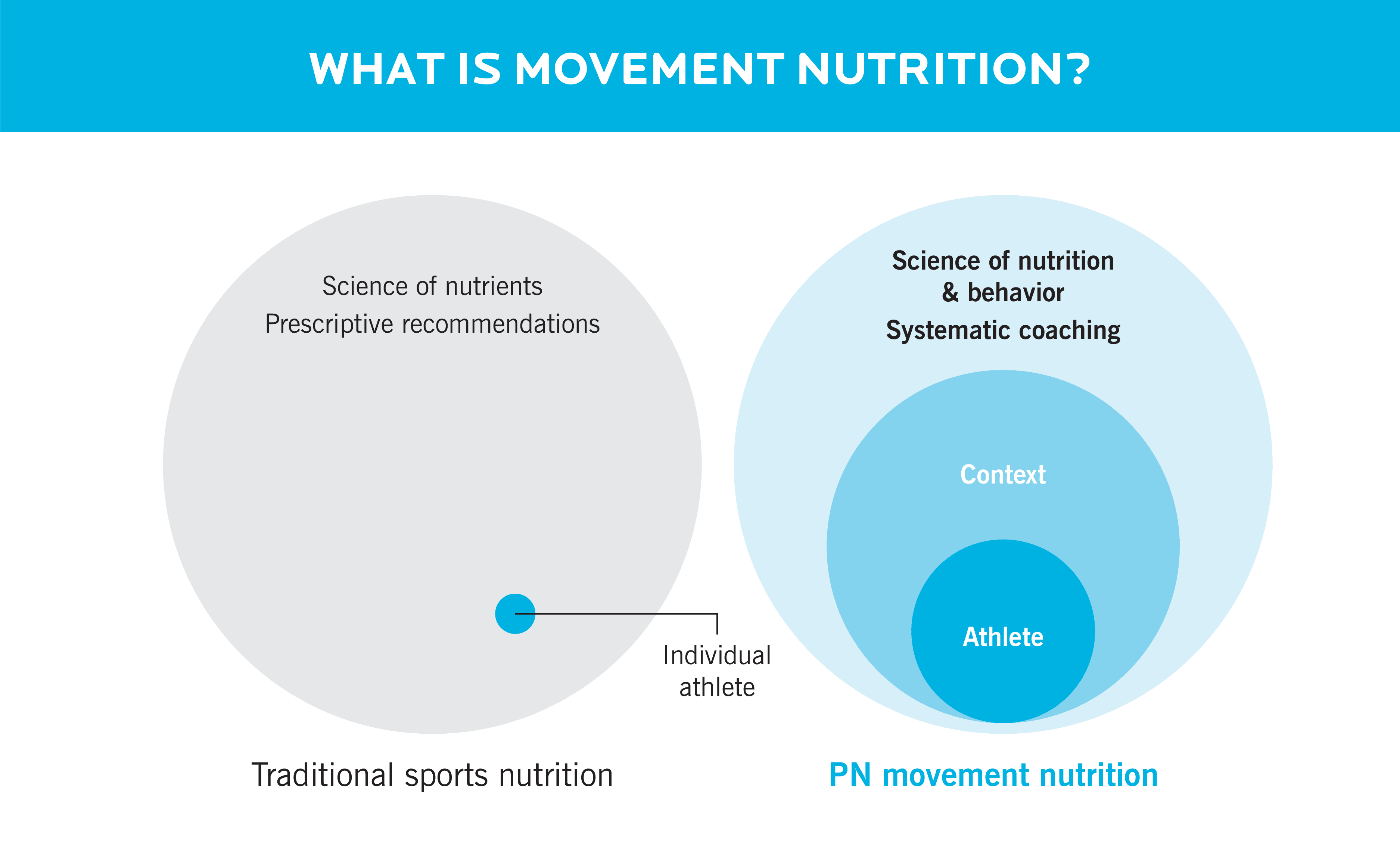
With movement nutrition, you still use nutrition science. But you expand your perspective to better understand and help each athlete as an individual.
New rule #2: Don’t ignore athletes’ psychological and social health.
Athletes aren’t just moving bodies. They’re real, unique people with real, unique lives.
Take Lorain, for instance—an accomplished powerlifter. Her dad owns a lifting gym, so she was raised between sets of squats.
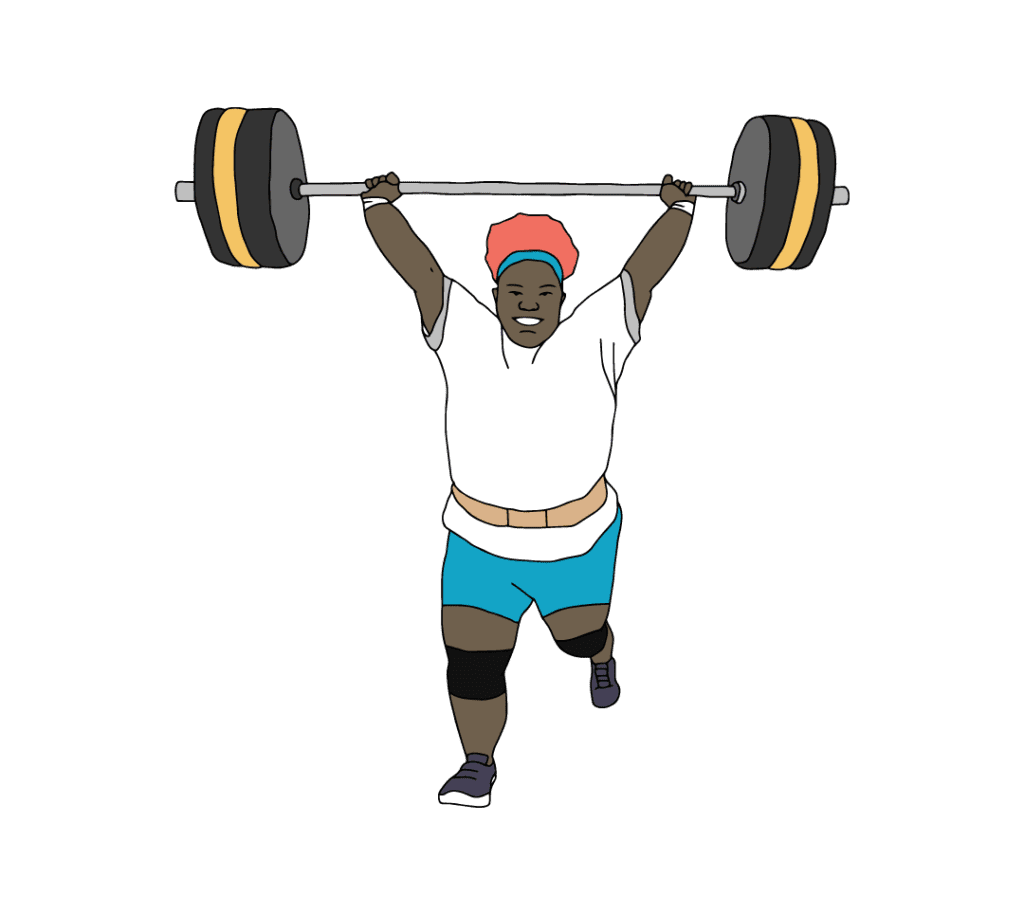
Lorain wants to qualify for Nationals, but she knows she has a better chance of making it if she cuts down to the 185-pound (84 kilogram) weight class. That’s why she came to you for coaching.
It sounds simple enough, right? Athletes cut weight all the time, and Lorain is clearly a hard worker. You’ll just gather info about her current height and weight, what she’s eating, how she’s training, and use that to create a plan that’ll get her into a calorie deficit. You’ll chip away at that goal together, slowly and sustainably. Easy.
But after a month, Lorain’s not seeing much progress, and you’re left scratching your head.
Here’s what you didn’t know about Lorain:
- She’s currently commuting to law school. She spends more time in the car than out of it—which means plenty of fast-food wrappers and empty soda bottles, and not much activity outside her workouts.
- She stays with her dad on weekends. While he’s super supportive of her powerlifting goals, he’s also a former heavyweight and proponent of the “eat big, lift big” school of thought. So he’s not as supportive of the idea of getting “smaller.” In a way, Lorain feels alone in her quest to reach a lower weight class.
- Between school, student loans, checking on her dad, and working a part-time job, Lorain is struggling to focus on her health and performance.
All three of these factors are making it harder for Lorain to stick to the plan you’ve created for her.
But you won’t find out about them unless you look beyond the obvious data.
This is where so many sports nutrition coaches go wrong.
Enter: The biopsychosocial model.
Lorain’s initial weight-cutting plan only took into account biological factors: her physical stats, eating habits, and workout routine.
But the psychological factors and social context are also important parts of the big picture. Lorain’s stressed from school, feeling alone, commuting in a less-than-ideal environment, and getting pressure from her dad.
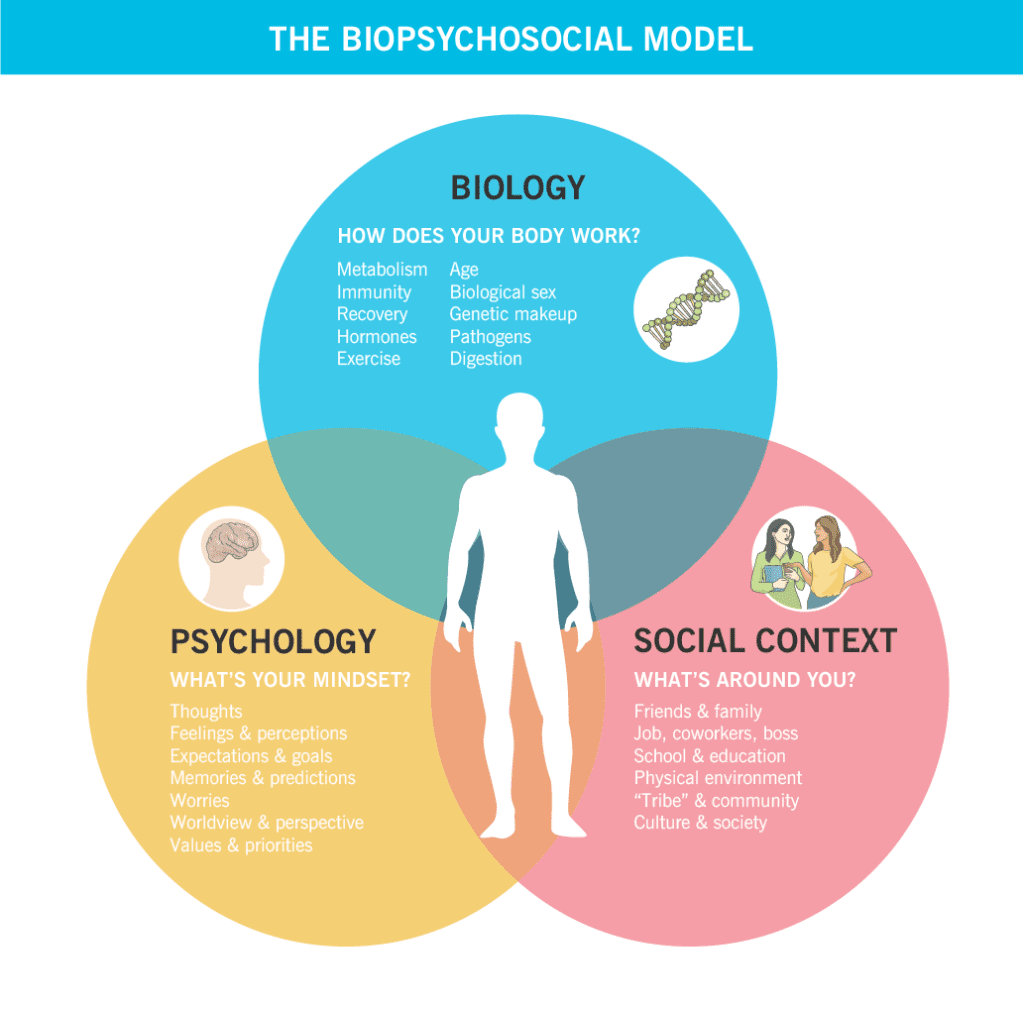
Asking about all aspects of your athletes’ lives will help you collaborate with them to develop customized nutrition plans that set you apart from other “just make a meal plan” coaching approaches.
That’ll improve the quality of their results. And bringing your client’s awareness to the factors that may be limiting their progress? That’s also likely to improve their quality of life.
(Deep health is another useful model for learning more about your active clients’ lives.)
And by the way, this isn’t just a good idea on paper. It comes from our direct experience working with clients.
The bottom line: Learn more about your clients as people.
That way, you can use your nutrition science knowledge and coaching skills to create a plan they enjoy, appreciate, and most importantly… will actually do.
New rule #3: Expand your definition of the word “athlete.”
Typically, we think of “sports nutrition” as something geared towards people who are “elite” in some way: pro basketball players, competitive marathon runners, and high school sports stars.
Not only does this mentality limit your pool of potential clients, it might also limit your clients’ results. After all, we’re seeing people with more diverse bodies, abilities, ages, and skills training and competing as athletes these days.
Valentina is a prime example. She’s in her 40s and runs a school for young girls and their pursuit of glory in the sport of charrería (Mexican rodeo).
After working with the girls all day, she spends another five to six hours taking care of all the horses, running the barn, and caring for her family.
It wasn’t a big deal when she was younger, but after years of under-eating and body image issues, it takes a bit more than a couple of NSAIDs to get Valentina back into the saddle and recover from a day’s work.
Valentina might not fit the typical definition of an “athlete,” but due to the active nature of her job and life, she could really benefit from a targeted nutrition strategy. One that’ll help support her busy and physically-demanding schedule.
The bottom line:
Elite athletes aren’t the only “movers” you can help.
Generally, there’s some point at which a person moves often and intensely enough to need or want some type of nutritional support.
Rather than lumping all athletes together, we use three categories to think about people who move their bodies and can benefit from targeted movement nutrition strategies.
- Athletes: Anyone who has the capacities, training, and skills to do a set of physical tasks, usually under specific circumstances (such as a sport with a particular set of rules), and often for the purpose of competition.
- Exercisers: Anyone who purposely does physical movement to improve and/or maintain health and wellness, function, and/or body composition—or simply for enjoyment.
- Movers: Anyone who moves their bodies relatively often and/or intensely—whether for work, play, or the demands of daily life.
These categories overlap. All athletes are movers, of course, but not all movers or exercisers are athletes. People can move in and out of different categories.
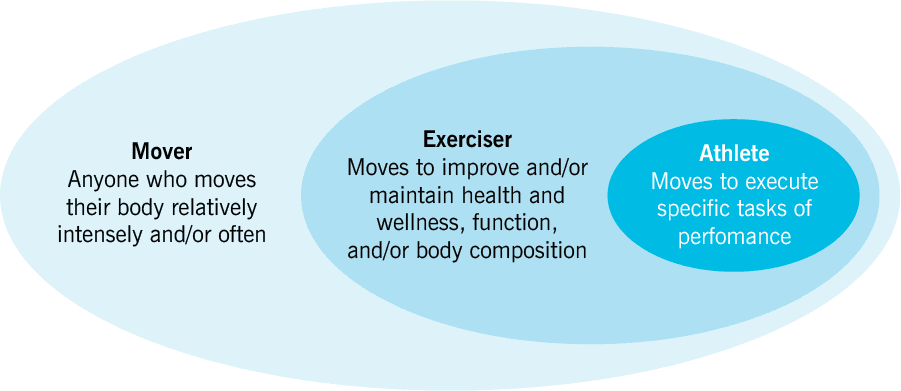
Our point: Most people aren’t professional athletes.
But you can help all active people, in some way, with nutritional support.
This mindset shift can translate to a broader pool of clients and ultimately, better results.
New rule #4: Focus on fundamentals before advanced nutrition methods.
Biochemistry is cool. And when you’ve got the science of nutrition down, it’s tempting to rely on the highest-level, most innovative and cutting-edge protocols you can think of.
But even the most talented athletes aren’t always advanced nutritionally. In fact, they’re often missing fundamental nutrition skills.
Take Stephen, for example. He’s a talented basketball player who’s just been given a college scholarship. Scouts have their eye on him as a future NBA pro.

Not only is Stephen great on the basketball court, he’s been terrific at every physical activity he tried.
Stephen is what you might call “jacked.” And at 18, he’s nearing his prime physical performance and physique.
So what’s his diet secret? Surprise! It’s Burger King, Taco Bell, Pizza Hut, KFC, and Frosted Flakes. Washed down with a Super Big Gulp from 7-11. In other words, whatever is cheap, fast, and easily available.
Turns out, Stephen’s secret to being ripped, swole, and a top athletic performer is youth, lots of activity, and good genes. Unfortunately, most of those gifts run out during an athletic career, and a poor diet will accelerate the process.
When it comes to athletes, Stephen is closer to the norm than an outlier.
Don’t knock nutrition basics—even for top-level athletes.
As his coach, you know that if Stephen wants to last through his college and professional seasons, he’s going to have to do some things differently.
But giving him a complicated plan with specific macro ratios? Or an elaborate nutrient timing protocol?
Considering how he’s currently eating, that’s probably not going to work.
So for Stephen and other athletes like him, consider developing fundamental skills like:
- Making time to plan out some of his meals for the week, so there are fewer last-minute decisions
- Scheduling meal times and stocking up on healthy, convenient, and budget-friendly options, so fast food becomes less of a necessity
- Adding more minimally-processed foods (instead of insisting Stephen stops eating fast food altogether)
- Using the “PN plate” template, to ensure Stephen is getting plenty of protein, vegetables, smart carbohydrates, and healthy fat in each meal
- Collaboratively building a red, yellow, and green-light foods list over time based on what helps Stephen feel his best during training
The takeaway: Basic nutrition habits can make a real difference—even for elite athletes.
New rule #5: Use a systematic coaching method.
The first time you meet an elite athlete client can be scary. You might be sitting across from a million-dollar body, and maybe their million-dollar coaches too.
Alternatively, you might be working with special ops military personnel. And they’re depending on you to help them pass selection.
Your newest client could also be a stay-at-home mom who doesn’t just want to run her neighborhood’s annual 5K; she wants to win.
Helping movers achieve their hopes and dreams can be a lot of pressure.
You need a coaching plan.
And not just any old plan. You need a coaching method. One that:
- can be a customized for a variety of types of clients
- provides a roadmap to help ensure you’re meeting each client’s unique needs
- helps you use the best available evidence to guide your decisions.
This is why we developed the Precision Nutrition Coaching Method. It’s a six-step coaching process that can help ask the right questions, and take the right actions, at the right time.
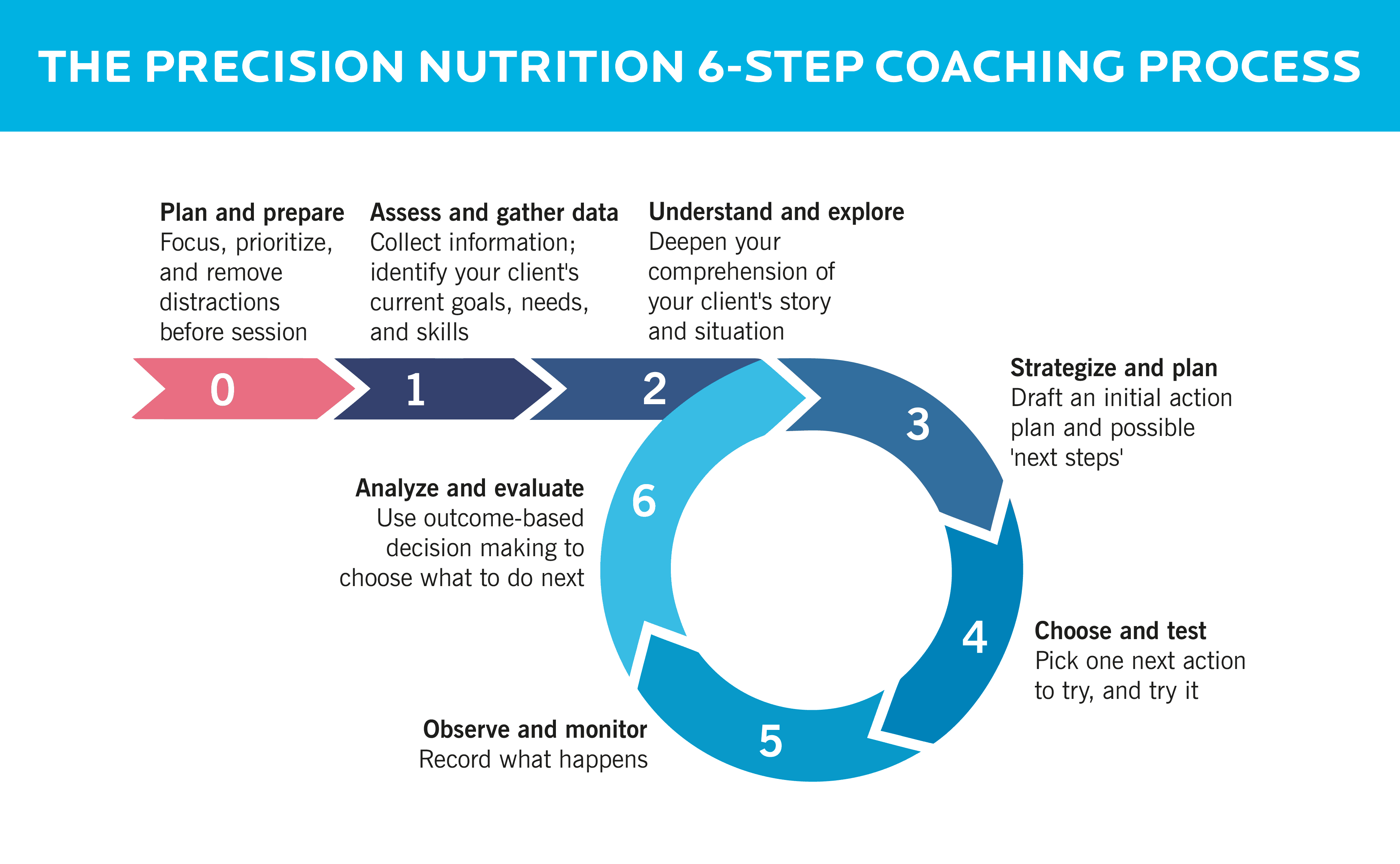
Here are the steps and some questions you might ask in each:
Before you start (step 0): Plan and prepare.
- Where and how am I doing this coaching session?
- What do I already know about my client, and what questions do I need to ask them?
- What forms, assessments, and measuring or monitoring tools do I need?
Step 1: Assess and gather data.
- What activities does my client do?
- What, exactly, are my client’s goals?
- What are some basic facts about my client?
Step 2: Understand and explore.
- What kind of person is my client?
- What is their life and daily routine like?
- What is their deeper purpose, or “why,” for achieving their goals?
- What are they ready, willing, and able to do right now?
Step 3: Strategize and plan.
- What are all the potential paths forward towards the goal?
- What’s most realistic and possible for my client?
- What’s one high-impact, low-effort thing my client can do right now?
Step 4: Choose and test.
- What exactly will you and your client do next?
- What is ONE task your client is willing to do every day, over and over, no matter what?
- If you choose a particular action, how will you and your client know whether it “works” or not? How will you define “success” or “progress?”
Step 5: Observe and monitor.
- Is the client doing the correct actions consistently?
- What do the data say is occurring?
- Is this plan demonstrably helping my client?
Step 6: Analyze and evaluate.
- Are we getting the results we seek? Why or why not?
- Is there something we could do differently or better?
- What should we change (if anything) moving forward?
(If you want to learn more about PN’s coaching method, we teach it in depth in our Level 1 Certification.)
The takeaway: systematize your coaching, and you’ll feel excited when an athlete comes to you with a big goal—not nervous.
We’re born to move.
Humans start moving well before we’re born. We emerge into the world flailing and grasping, with built-in movement reflexes firing.
Unless we’re constrained, paralyzed, or otherwise actively prevented from movement, we move throughout our lives until we die.
By expanding the idea of what it means to be a sports nutrition coach, we can more effectively understand, plan, and implement good nutrition practices for a wide range of active clients.
Because it’s not just about energy and nutrients.
It’s about performing and winning… and staying sharp and energetic. And recovering. And having a long, healthy, active life.
If you’re a coach, or you want to be…
Learning how to coach clients, patients, friends, or family members through healthy eating and lifestyle changes—in a way that’s personalized for their unique body, preferences, and circumstances—is both an art and a science.
If you’d like to learn more about both, consider the Precision Nutrition Level 1 Certification. The next group kicks off shortly.
The post Level 1: The new rules of sports nutrition: This could revolutionize the way you coach athletes. appeared first on Precision Nutrition.
Powered by WPeMatico



Sorry, the comment form is closed at this time.